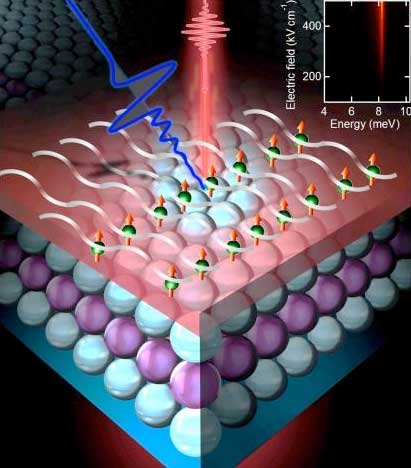| Feb 18, 2020 | |
Topological materials outperform through quantum periodic motion(Nanowerk News) Scientists at the U.S. Department of Energy’s Ames Laboratory have discovered that applying vibrational motion in a periodic manner may be the key to preventing dissipations of the desired electron states that would make advanced quantum computing and spintronics possible (npj Quantum Materials, "Light Control of Surface-Bulk Coupling by Terahertz Vibrational Coherence in a Topological Insulator"). |
|
| Some topological materials are insulators in their bulk form, but possess electron-conducting behavior on their surfaces. While the differences in the behavior of these surface electrons is what makes these materials so promising for technological applications, it also presents a challenge: uncontrolled interactions between surface electrons and the bulk material states can cause electrons to scatter out of order, leading to so-called “topological breakdown”. They are not protected by any “spontaneous” symmetry. | |
 |
|
| Ames Laboratory scientists took a paradoxical approach, called dynamic stabilization, by applying a terahertz electric field to drive periodic lattice oscillations in a model topological insulator. These additional fluctuations actually enhanced protected topological states. (Image: Ames Laboratory) | |
| “Topological insulators that can sustain a persistent spin-locked current on their surfaces which does not decay are termed ‘symmetry protected,’ and that state is compelling for multiple revolutionary device concepts in quantum computing and spintronics,” said Jigang Wang, Ames Laboratory physicist and Iowa State University professor. “But the topological breakdown due to surface-bulk coupling is a long standing scientific and engineering problem.” | |
| Wang and his fellow researchers took a paradoxical approach, called dynamic stabilization, by applying a terahertz electric field to drive periodic atomic vibrations, i.e., vibrational coherence, in the model topological insulator bismuth-selenium Bi2Se3. These extra “fluctuations” actually enhanced protected topological states, making the electronic excitations longer lived. | |
| An analogy of such dynamic stabilization is the periodically driven Kapitza pendulum, known by Nobel Laureate Peter Kapitza, where an inverted, yet stable, orientation is achieved by imposing a sufficiently high-frequency vibration of its pivot point. In a similar manner, additional dynamic stabilization can be achieved by driving quantum periodic motions of the lattice. | |
| “We demonstrate the dynamic stabilization in topological matter as a new universal tuning knob, that can be used to reinforce protected quantum transport,” said Wang, who believes the discovery has far-reaching consequences for the use of these materials to many scientific and technological disciplines, such as disorder-tolerant quantum information and communications applications and spin-based, lightwave quantum electronics. |
| Source: Ames Laboratory | |
|
Subscribe to a free copy of one of our daily Nanowerk Newsletter Email Digests with a compilation of all of the day's news. |
